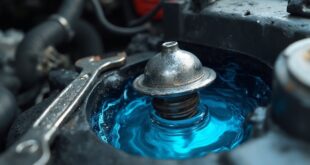If your turn signal's blinking fast, it usually means there's a problem, like a burnt-out bulb, wiring issues, or a faulty relay. Start by checking all bulbs visually and replace any that are dim or blown. Next, inspect the wiring for signs of damage or corrosion. It could also be a defective relay, which affects both turn signals and hazard lights. Keep going to find out more about fixing these common issues!
Common Causes of Fast Blinking Turn Signals
When you notice your turn signal blinking faster than usual, it's often a clear sign that something's amiss.
One common cause is a bad bulb, which alters the electrical resistance. Insufficient voltage from your battery or wiring issues can also lead to rapid blinking.
A malfunctioning relay, especially one that's rusted, may speed up the signal operation too. Sometimes, a defective fuse can unexpectedly contribute to faster blinking.
Finally, ground connection issues can disrupt the signal's function, causing it to blink unusually fast.
Addressing these problems promptly guarantees your signals work properly and keeps you safe on the road.
How to Inspect Turn Signal Bulbs
Inspecting your turn signal bulbs is essential for ensuring they function properly. Start with a visual check of all bulbs, paying special attention to the one that's blinking fast.
Assess the condition of surrounding lights; if they're also dim or flickering, the issue might be broader. Make sure you're using the correct bulb type with the right resistance.
Don't forget to check fender turn signal bulbs, as they can often be overlooked. If you find a faulty bulb, you'll most likely need to replace it to restore normal blinking speed.
Proper inspection can save you time and hassle later.
Steps to Replace a Defective Bulb
To replace a defective turn signal bulb, start by accessing the bulb's location, which may require opening the hood or trunk.
Next, disconnect the electrical connector by pressing the locking tab. Once the connector is free, remove the defective bulb by unscrewing it or pulling it out, depending on the type.
Take your new bulb and insert it correctly into the socket, ensuring it fits snugly.
Finally, reconnect the electrical connector and test the turn signals to confirm everything's working properly. If they blink at the right speed, you've successfully replaced the bulb!
Checking Wiring and Voltage Issues
Before diving into repairs, it's crucial to check the wiring and voltage to confirm your turn signals are functioning properly.
Here's what you should do:
- Battery Voltage: Confirm the battery's supplying adequate voltage. If it's low, charge or replace it.
- Inspect Wiring: Look for damaged or corroded wires that could disrupt electrical flow.
- Connector Testing: Verify all connectors are functioning and delivering proper current.
Don't overlook the fuse condition; a blown fuse can cause issues as well.
Addressing these wiring and voltage issues can help you pinpoint the cause of that fast blinking!
Examining and Replacing the Relay
After checking the wiring and voltage, the next step is to examine the relay responsible for your turn signals.
Listen for clicking sounds when you activate the turn signal; if you don't hear anything, the relay might be faulty. A malfunctioning relay can affect both your turn signals and hazard lights.
If you suspect it's the issue, you can replace it yourself or seek professional help. Replacement costs range from $10-$20 for the relay, but labor might add another $35-$50 if you hire someone.
Addressing this quickly can restore proper signal functionality.
Frequently Asked Questions
Can Fast Blinking Turn Signals Indicate a Serious Electrical Problem?
Fast blinking turn signals can indicate an electrical issue, but it's often a simple bulb problem. Check the bulbs and wiring first; if everything seems fine, consult a professional to avoid serious complications.
How Can I Prevent Fast Blinking Turn Signals in the Future?
To prevent fast blinking turn signals, regularly check your bulbs and wiring for damage. Guarantee you use the correct bulbs, maintain proper voltage, and replace any faulty components promptly to guarantee everything functions smoothly.
Are Fast Blinking Turn Signals Legal to Use on the Road?
Fast blinking turn signals aren't illegal, but they can confuse other drivers. You should guarantee your signals function properly to maintain safety and clarity on the road, avoiding potential misunderstandings during lane changes or turns.
What Tools Do I Need to Inspect My Turn Signal System?
To inspect your turn signal system, you'll need a screwdriver, a multimeter for voltage testing, a flashlight for visibility, and possibly a replacement bulb. These tools help diagnose and fix any issues effectively.
How Often Should I Check My Turn Signal Bulbs?
You should check your turn signal bulbs regularly, ideally during routine maintenance or oil changes. This guarantees they're functioning properly and helps prevent issues like fast blinking or complete signal failure down the road.
 Car Service Land Coupons for Oil change, Tires, Wheel alignment, Brakes, Maintenance
Car Service Land Coupons for Oil change, Tires, Wheel alignment, Brakes, Maintenance




